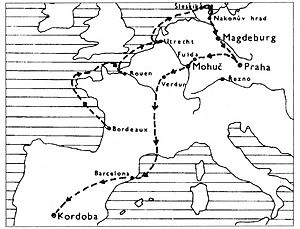Ibrahim ibn Yaqub facts for kids
Ibrahim ibn Yaqub was a fascinating traveler, possibly a merchant, who lived in the 900s. He was a Sephardi Jewish person from Ṭurṭūšah (which is now Tortosa, Spain). He might have also lived in Córdoba. He was known for his amazing journeys and for writing down what he saw and learned.
About Ibrahim ibn Yaqub
Ibrahim ibn Yaqub's family came from a part of Spain ruled by Moors, near the Ebro River. His own writings and other historical records suggest he had a Jewish background. However, some historians wonder if he was a Muslim who came from a Jewish family. It's a bit of a mystery!
His Amazing Journeys
Around the years 961–962, Ibrahim ibn Yaqub traveled a lot. He explored Western and Central Europe, and even went to Italy. He traveled as far as Rome, where he met the powerful Holy Roman Emperor Otto I. This meeting happened in early February of that year.
We don't know much about his trip back home to al-Andalus (the Muslim-ruled part of Spain) or if he went on any more adventures. Sadly, his original travel diary, which he might have shown to the Cordoban ruler Al-Hakam II, has been lost over time. But don't worry! Parts of his writings were saved because other authors, like Abu Abdullah al-Bakri and Zakariya al-Qazwini, copied them into their own books.
What He Wrote About
Ibrahim ibn Yaqub's writings are super important because they give us the first reliable descriptions of the early Polish state. He wrote about Mieszko I, who was the first known ruler of Poland.
He also described the Vikings who lived in a place called Hedeby. He wrote about a strong fort belonging to the Nakonid people at Mecklenburg Castle. He even described what was probably the very beginning of the famous castle and palace at Schwerin.
For Czech history, Ibrahim ibn Yaqub is special because he was the first person to write about the city of Prague and its Jewish community. He also mentioned the Czech ruler Boleslaus I, Duke of Bohemia and the city of Krakow as part of the Duchy of Bohemia. His observations give us a unique peek into what Europe was like over a thousand years ago!
See also
 In Spanish: Ibrahim ibn Ya'qub para niños
In Spanish: Ibrahim ibn Ya'qub para niños
- Vineta
- At-Turtushi
- Benjamin of Tudela


